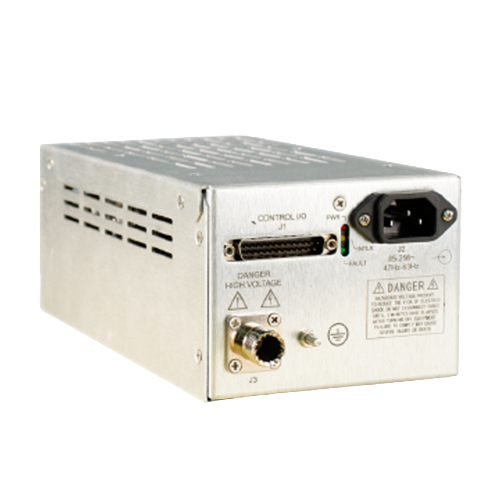Research on Optimization and Application of Sputtering Rate in Magnetron Sputtering High-Voltage Power Supplies
As a core process in physical vapor deposition (PVD), the sputtering rate in magnetron sputtering directly determines the efficiency and quality of thin-film preparation. The high-voltage power supply, serving as the key driving unit of the magnetron sputtering system, plays a decisive role in regulating the sputtering rate. This article systematically analyzes the influencing factors and optimization strategies for sputtering rates, focusing on high-voltage power supply parameters, magnetic field design, gas environment, and process innovations.
1. Direct Impact of High-Voltage Power Supply Parameters on Sputtering Rate
1. Voltage and Ion Energy Regulation
The output voltage of the high-voltage power supply governs the kinetic energy of argon ions. Increasing the voltage enhances the sputtering yield of target atoms by boosting ion bombardment energy. Studies show that raising the voltage from 300 V to 600 V can improve the sputtering rate of nickel targets by approximately 40%. However, excessive voltage may lead to substrate overheating and film stress accumulation, necessitating coordinated control via cooling systems and bias voltages.
2. Current Density and Plasma Density Correlation
The sputtering current reflects ion flux in the plasma. Under optimized pressure (0.1–1 Pa), higher currents exponentially increase plasma density, significantly elevating the number of ions bombarding the target per unit time. For instance, increasing current density from 0.5 A/cm² to 1.2 A/cm² can boost aluminum deposition rates by 2.3 times. Pulse power supplies (10–350 kHz) are critical for managing localized target overheating.
3. Frequency-Dependent Energy Transfer Efficiency
In radiofrequency (RF) and medium-frequency (MF) sputtering modes, power supply frequency alters energy transfer efficiency by modulating plasma sheath oscillations. A 13.56 MHz RF power supply decouples ion and electron trajectories, reducing secondary electron energy transfer to substrates, thereby enabling high-power operation without damaging thermally sensitive materials. Experiments demonstrate that pulsed mid-frequency power (40 kHz) can increase alumina deposition rates by 18% while maintaining substrate temperatures below 150°C.
2. Synergistic Effects of Magnetic Field and Gas Environment
1. Magnetic Field Confinement for Electron Trapping
Closed magnetic field designs confine electrons near the target surface, extending their trajectories via E×B drift and enhancing argon ionization rates by 3–5 times. For high-permeability targets (e.g., nickel), unbalanced magnetic field configurations compensate for magnetic short-circuit effects, achieving sputtering rate uniformity within ±5% through gradient field strengths of 200–500 mT.
2. Dynamic Balance of Gas Pressure and Composition
Optimizing working pressure balances sputtering yield and film quality. Low-pressure environments (0.3 Pa) extend the mean free path of sputtered atoms, improving deposition rates but risking columnar film growth. Higher pressure (1.5 Pa) enhances film density at the cost of reduced rates. Introducing reactive gases (e.g., O₂/N₂) requires precise gas ratio control (Ar:O₂=20:1) to maintain stable sputtering rates during compound synthesis.
3. Process Optimization Strategies and Industrial Applications
1. Multi-Parameter Coupling Control Model
A three-dimensional process window integrating voltage, current, and pressure enables machine learning algorithms to predict optimal parameter combinations. For perovskite films, maintaining a target-substrate distance of 80–100 mm and a bias voltage of -100 V achieves a sputtering rate of 120 nm/min with high crystallinity.
2. Innovative Pulsed Power Applications
Bipolar pulsed power supplies eliminate target surface charge accumulation via microsecond-scale voltage reversal. Optimizing pulse duty cycles to 70% increases ITO sputtering rates by 25% while suppressing arc discharges.
3. System-Level Energy Efficiency Enhancement
Adaptive magnetron cooling technologies improve power conversion efficiency from 75% to 92%, reducing energy consumption by 1.2 kWh per square meter of film. Coupled with vacuum chamber flow field optimization, batch production cycles can be shortened by 30%.
4. Future Technological Trends
Advances in digital control of high-voltage power supplies will integrate real-time plasma spectroscopy monitoring and closed-loop parameter feedback. Finite element modeling of multi-physics field coupling (magnetic, electric, and gas flow) promises to突破 theoretical sputtering rate limits. By 2026, ultra-high-frequency (>100 MHz) power supplies are expected to achieve metal film deposition rates exceeding 500 nm/min, driving large-scale applications in flexible electronics and photovoltaics.




















